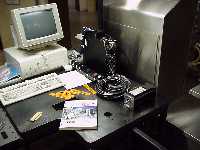

Motor
The motor is a 4-pole, three-phase AC brushless motor with built-in rotary
encoder and temperature monitoring. It is a 5,000 step per
revolution servo motor, capable of providing 9,000 oz-in continuously
or peak of 18,000 oz-in. The motor has permanent magnets on
the rotor making it synchronous to the frequency supplied by the drive.
Were the motor not synchronous by either permanent magnets or DC
windings on the rotor, (like a regular three phase motor) there would
be a slip of the shaft rotation behind the frequency -- this slip is
necessary to produce torque on all induction and squirrel cage motors.
This would make for inaccurate speed control; motor speed would
be determined by the load as well as frequency. It would be
almost useless in a precise positioning, velocity & acceleration
control, and would have no holding torque when not in motion.
Drive
The drive is made up of two parts, the AC frequency drive and the CPU with I/O terminals. The frequency drive is connected directly to the motor and is controlled by the CPU, making the ZX a self contained Servo System. The CPU is receives information from the motor through the rotary encoder, as well as limit switches placed according to application (the Home, CW & CCW limits). The CPU must be first programmed before it can be used in any application. This is done by using DOS based XWare software through a Tx/Rx/Vo RS-232 connection. The CPU can receive further inputs from a PLC, switches, thumbwheels and/or a computer terminal. After it is programmed, the ZX can be run with or without either a PLC or computer connection.
Programming
The ZX is programmed in a basic programming language made up of commands, and
organized in sequences. The program is then stored on
battery backed RAM in the CPU (like with a PLC). Commands
can range from simple Acceleration and Velocity values, I/O
designations, mathematical equations, to more complex logic controls
and Boolean Algebra such as IF/Then, Gosub, And/Or, Else, Until, and
others. Commands can also be entered through a computer or
through inputs set up to execute commands in the program.
See the ZX/ZXF Indexer Drive User Guide for more information on programming (pages 26-91), as well as programs listed and explained below. The ZX/ZXF Indexer Drive Software Reference Guide is not useful for this purpose; most necessary commands are listed in the User Guide. The Software Reference Guide is useful after the programming language and usage is understood, like a dictionary.
Applications
Unlike steppers, brushless AC as well as brushless DC motors have the
advantage of good resolution at slow speeds and a lower running
temperature. Servo motors have a wide verity of uses
including robotics, CNC machinery, indexing, and special conveyor and
lift controls.
--
Evan Garrett
Paul Adleman
March 20, 2000
2nd year APKG